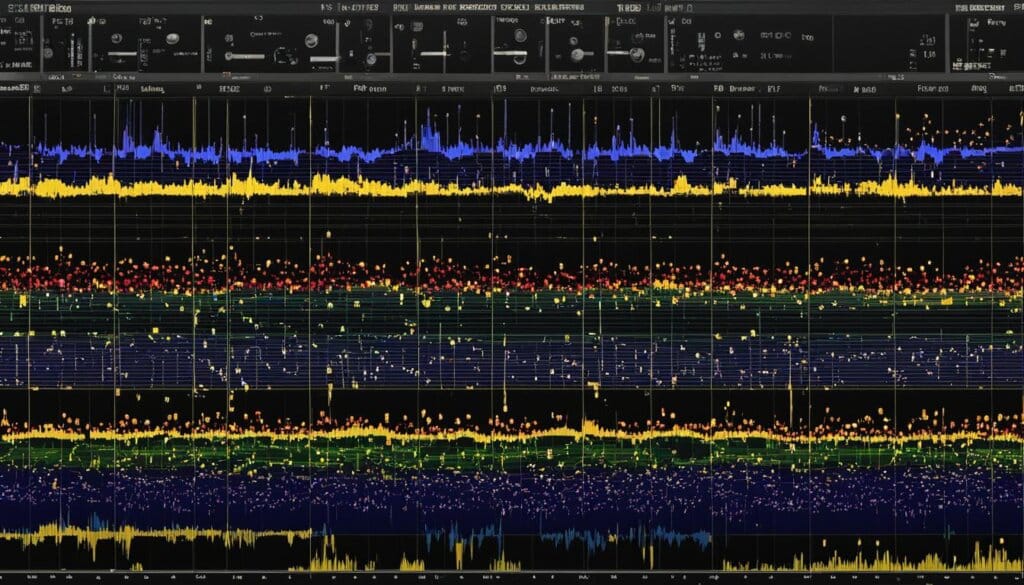Table of Contents
Multiplexing, often referred to as muxing, is a process that allows for the simultaneous transmission of multiple signals or streams of information over a single communication link. It combines these signals into a single complex signal for efficient transmission. At the receiving end, the process of demultiplexing separates the signals and outputs them to individual lines.
Multiplexing is used in various industries, including telecommunications, radio, television, and computer networks, to consolidate multiple signals into a single composite signal that is transmitted over a shared medium. This consolidation helps to optimize network resources and enable devices to communicate with each other without the need for dedicated connections between each pair of devices.
What is Multiplexing Used For?
Multiplexing serves a crucial role in a wide range of industries, facilitating both analog and digital communications. Since its introduction in the 1870s to support telegraphy, it has become a mainstay in various sectors, including telecommunications, radio, television, and telephone systems. Additionally, multiplexing is widely used in computer networks to transmit multiple signals across a wide area network (WAN).
Organizations implement multiplexing to enable devices to communicate with each other without the need for dedicated connections between each device pair. This optimization of network resources not only improves efficiency but also proves valuable in situations where resources are scarce or expensive, such as satellite uplinks or cable/fiber strands between major metropolitan areas.
Analog communications rely on multiplexing to process signals, enabling smooth telecommunication operations. This includes the transmission of analog signals used in telephones and television broadcasting. Digital communications, on the other hand, heavily depend on multiplexing techniques to transmit multiple digital signals over a single channel, enhancing the efficiency of computer networks and enabling seamless data transmission between devices.
Multiplexing plays a crucial role in optimizing network resources, improving efficiency, and enhancing the overall communication experience.
Applications of Multiplexing:
- Telegraphy: The use of multiplexing in telegraphy revolutionized long-distance communication, improving the speed and efficiency of transmitting messages.
- Telecommunications: Multiplexing is integral to the functioning of modern telecommunications systems, allowing for the transmission of voice, data, and video signals simultaneously.
- Radio and Television: Multiplexing enables the transmission of different radio and television channels over the airwaves, optimizing bandwidth and allowing for the simultaneous broadcast of multiple programs.
- Computer Networks: Multiplexing techniques are essential in computer networks, allowing multiple devices to share the same network infrastructure and transmit data simultaneously.
Multiplexing has become an indispensable tool in the realm of communication, enabling efficient and seamless transmission of signals across various industries.
Types of Multiplexing
Organizations have multiple options when it comes to selecting the type of multiplexing technique to use. The choice depends on the type of signals being transmitted (analog or digital) and the medium used for transmission (coaxial cable, fiber optic cable, microwave link, etc.). Some common types of multiplexing include:
1. Frequency-Division Multiplexing (FDM)
Frequency-division multiplexing (FDM) combines multiple signals by allocating different frequency ranges to each channel. Each channel occupies a distinct frequency, enabling simultaneous transmission across a shared medium. FDM is commonly used in radio broadcasting and cable television.
2. Wavelength-Division Multiplexing (WDM)
Wavelength-division multiplexing (WDM) multiplexes optical signals with different wavelengths onto a single fiber optic cable. By utilizing multiple wavelengths, WDM can transmit multiple streams of data simultaneously. WDM is widely used in high-speed optical communication systems, such as long-haul fiber networks.
3. Time-Division Multiplexing (TDM)
Time-division multiplexing (TDM) divides a transmission into multiple time slots, with each slot assigned to different channels. Each channel takes turns transmitting its data within the time slots, creating the illusion of simultaneous transmission. TDM is commonly used in digital telephony and digital audio broadcasting.
4. Code-Division Multiplexing (CDM)
Code-division multiplexing (CDM) assigns a unique code to each channel and combines them into a single, encoded stream. The combined signal is then transmitted over a shared medium. At the receiving end, the decoder extracts individual channels using the assigned codes. CDM is widely used in wireless communication systems, such as 3G and 4G networks.
5. Space-Division Multiplexing (SDM)
Space-division multiplexing (SDM) utilizes multiple physical conductors, such as optical fibers or electrical wires, to separate signal paths. Each conductor handles a transmitted channel, allowing for simultaneous transmission of multiple signals. SDM is commonly used in submarine cable systems and wireless communications.
6. Polarization-Division Multiplexing (PDM)
Polarization-division multiplexing (PDM) divides electromagnetic signals into orthogonal channels based on their polarization states. These channels are then transmitted through a common medium without interference. PDM is often used in fiber optic communications and satellite transmissions to increase bandwidth capacity and improve system performance.
Analog Multiplexing
Analog multiplexing is a widely used technique in the field of telecommunication to process analog signals, such as those used in telephones and television. It allows for the efficient transmission of multiple analog signals over a single communication link, optimizing network resources and enabling effective communication between devices without the need for dedicated connections between each pair of devices.
The two main techniques used for analog multiplexing are frequency-division multiplexing (FDM) and wavelength-division multiplexing (WDM). FDM involves combining different frequencies to merge data streams and send them as a single signal. This technique is commonly used in radio and cable TV, where different frequencies are allocated to different channels. On the other hand, WDM multiplexes multiple optical carrier signals onto a single fiber optic cable using different wavelengths of light. This technique is implemented in high-capacity communication networks to maximize the utilization of fiber optic cables.
By employing analog multiplexing techniques, telecommunication systems can transmit multiple analog signals simultaneously, enhancing the efficiency and effectiveness of communication networks.

Advantages of Analog Multiplexing
Analog multiplexing offers several advantages in telecommunication:
- Optimizes network resources: By combining multiple analog signals into a single transmission, analog multiplexing optimizes the utilization of network bandwidth, boosting efficiency and reducing costs.
- Facilitates simultaneous communication: Through analog multiplexing, multiple devices can communicate simultaneously over the same channel without interference, enabling efficient and seamless communication.
- Simplifies infrastructure: Analog multiplexing eliminates the need for dedicated connections between each pair of devices, simplifying infrastructure requirements and reducing complexity in telecommunication systems.
- Enhances scalability: With analog multiplexing, telecommunication systems can easily scale to accommodate increasing communication needs without significant infrastructure changes.
Comparison Between FDM and WDM
Below is a comparison table highlighting the key differences between frequency-division multiplexing (FDM) and wavelength-division multiplexing (WDM):
| FDM | WDM |
|---|---|
| Combines different frequencies to merge data streams | Multiplexes optical carrier signals onto a single fiber optic cable using different wavelengths of light |
| Commonly used in radio and cable TV | Utilized in high-capacity communication networks |
| Divides available bandwidth into frequency slots | Allocates different wavelengths of light to each optical carrier signal |
| Requires filters to separate individual frequency channels | Uses multiplexers and demultiplexers to handle different wavelengths |
Understanding the differences between FDM and WDM helps telecom professionals choose the most appropriate technique for their specific needs and ensure efficient analog signal transmission.
Digital Multiplexing
Digital multiplexing plays a crucial role in computer networking by enabling the transmission of multiple signals over a single channel. This technique optimizes bandwidth utilization and enhances the efficiency of data transmission in various digital communication systems.
Time-Division Multiplexing (TDM)
Time-division multiplexing (TDM) is a commonly used digital multiplexing technique. In TDM, digital signals are divided into time slots and transmitted sequentially. Each signal is allocated a specific time slot within a frame, and multiple signals are interleaved to form a composite signal for transmission.
TDM is widely used in digital telephony and Synchronous Optical Network (SONET) links. By dividing the available time into slots, TDM enables multiple signals to be transmitted over a single channel, maximizing the utilization of network resources.
Code-Division Multiplexing (CDM)
Code-division multiplexing (CDM) is another important digital multiplexing technique. In CDM, each signal is assigned a unique spreading code, which is combined with the original signal to create an encoded data stream. The encoded signals are then transmitted simultaneously and separated at the receiving end using the corresponding spreading codes.
CDM is commonly used in digital television and radio broadcasting, as well as 3G mobile cellular networks. By using unique spreading codes, CDM allows multiple signals to coexist in the same frequency band without interference, enabling efficient utilization of available spectrum.
| Multiplexing Technique | Application |
|---|---|
| Time-Division Multiplexing (TDM) | Digital telephony, SONET links |
| Code-Division Multiplexing (CDM) | Digital television and radio broadcasting, 3G mobile cellular networks |
By employing digital multiplexing techniques like TDM and CDM, computer networks can efficiently transmit digital signals over a single channel, optimizing bandwidth utilization and enabling seamless communication.
Space-Division Multiplexing
Space-division multiplexing (SDM) is a multiplexing technique that involves the separation of signal paths using multiple physical conductors, such as optical fibers or electrical wires. These conductors are bundled together into a single transport medium, but they are physically separated, with each conductor handling a transmitted channel. SDM enables the simultaneous transmission of multiple signals through the use of separate and dedicated paths, thereby increasing capacity and improving the efficiency of data transmission.
In SDM, the individual conductors serve as the transmission medium for each channel, allowing for efficient and parallel signal transmission. This technique is particularly advantageous in scenarios where there is a need to transmit large volumes of data simultaneously, as it helps prevent bottlenecks and congestion in the communication network.
SDM can be further enhanced through the use of other multiplexing techniques, such as frequency-division multiplexing (FDM), time-division multiplexing (TDM), or code-division multiplexing (CDM). These additional techniques enable the simultaneous transmission of multiple signals within each individual conductor, further optimizing the use of available bandwidth.
Advantages of Space-Division Multiplexing:
- Increased capacity: SDM allows for the transmission of multiple channels simultaneously, resulting in higher data throughput and improved network performance.
- Efficient use of resources: By utilizing separate physical conductors for each channel, SDM optimizes the use of available bandwidth, reducing the likelihood of congestion and improving overall network efficiency.
- Improved reliability: The physical separation of channels in SDM ensures that any disruptions or failures affecting one channel do not impact the transmission of other channels. This enhances the reliability and robustness of the communication system.
- Flexibility: SDM can be combined with other multiplexing techniques, enabling customizable and adaptable solutions to meet specific communication requirements.
Application of Space-Division Multiplexing:
SDM is commonly used in various industries, including telecommunications, data centers, and broadcasting. It is particularly prevalent in submarine cable systems, where it helps to increase the capacity and efficiency of data transmission over long distances. SDM is also employed in wireless communication systems to improve signal quality and reduce interference. Additionally, the use of SDM in optical fiber networks enables high-speed and reliable data transmission, making it a critical component of modern communication infrastructure.
| Industry | Applications |
|---|---|
| Telecommunications | High-speed data transmission, long-distance communication |
| Data Centers | Efficient server-to-server communication, improved network performance |
| Broadcasting | Simultaneous transmission of multiple audio and video channels |
| Wireless Communication | Improvement of signal quality, reduction of interference |
| Optical Fiber Networks | High-speed and reliable data transmission |
Polarization-Division Multiplexing
Polarization-division multiplexing (PDM) is an advanced technique used in modern communication systems to efficiently transmit electromagnetic signals over a common medium. By polarizing these signals into orthogonal channels, PDM enables the simultaneous transmission of multiple signals without interference, thereby increasing capacity and enhancing the robustness of communication systems.
PDM finds significant application in fiber optic communications and satellite transmissions, where it optimizes the utilization of available resources and ensures reliable data transmission. In fiber optic communications, PDM utilizes the polarization states of light to create separate channels for signal transmission.
The use of orthogonal channels in PDM enables the transmission of different signals with different polarization states, which helps to prevent signal interference and improve the overall performance of the communication system.
By employing PDM in satellite transmissions, orthogonal channels can be effectively utilized to transmit multiple signals simultaneously, maximizing the utilization of available bandwidth and enhancing the efficiency and reliability of satellite communication.
Overall, polarization-division multiplexing is a powerful technique that enables efficient transmission of electromagnetic signals by utilizing orthogonal channels. Its application in fiber optic communications and satellite transmissions plays a crucial role in optimizing network resources and ensuring reliable and high-performance communication.
Build Efficient Networks at Scale
Multiplexing plays a crucial role in building efficient networks, especially at scale. By optimizing bandwidth, organizations can make the most of the available resources and transmit multiple signals simultaneously over a single communication link. This allows for efficient use of network capacity, preventing system crashes caused by overflowing channels.
Effective networking is essential for organizations to facilitate seamless communication and data transmission. Multiplexing improves internal communication within networks, enabling devices to share information without the need for dedicated connections between each pair of devices. With the rise of remote work and the shift toward 5G telecommunications, the demand for efficient networking solutions has never been higher.
Multiplexing provides an effective and cost-efficient means for network engineers to manage and transmit high volumes of data. By consolidating millions of signals efficiently, organizations can optimize their network resources and prevent bottlenecks. As the digital transformation continues to drive innovation, the skills of network engineers who understand multiplexing become increasingly valuable in building and maintaining the networks of the future.
FAQ
What is multiplexing?
Multiplexing is a process that allows for the simultaneous transmission of multiple signals or streams of information over a single communication link. It combines these signals into a single complex signal for efficient transmission.
What is multiplexing used for?
Multiplexing is used in various industries, including telecommunications, radio, television, and computer networks, to consolidate multiple signals into a single composite signal that is transmitted over a shared medium. This helps optimize network resources and enables devices to communicate with each other without the need for dedicated connections.
What are the types of multiplexing?
There are several types of multiplexing, including frequency-division multiplexing (FDM), wavelength-division multiplexing (WDM), time-division multiplexing (TDM), code-division multiplexing (CDM), space-division multiplexing (SDM), and polarization-division multiplexing (PDM).
What is analog multiplexing?
Analog multiplexing is commonly used in telecommunications to process analog signals. It involves techniques such as frequency-division multiplexing (FDM) and wavelength-division multiplexing (WDM) to combine and transmit data streams as a single signal.
What is digital multiplexing?
Digital multiplexing is commonly used in computer networking to transmit multiple signals over a single channel. Techniques such as time-division multiplexing (TDM) and code-division multiplexing (CDM) are used to divide and encode digital signals for transmission.
What is space-division multiplexing?
Space-division multiplexing involves separating signal paths through the use of multiple physical conductors, such as optical fibers or electrical wires. These conductors are bundled into a single transport medium but are physically separated, with each conductor handling a transmitted channel.
What is polarization-division multiplexing?
Polarization-division multiplexing is a technique that polarizes electromagnetic signals into orthogonal channels, which are then transmitted through a common medium. This method is often used in fiber optic communications and satellite transmissions.
How does multiplexing help build efficient networks at scale?
Multiplexing allows for the optimal use of available bandwidth, prevents system crashes caused by overflowing channels, and improves internal communication within networks. It provides an effective means for network engineers to manage and transmit high volumes of data.













